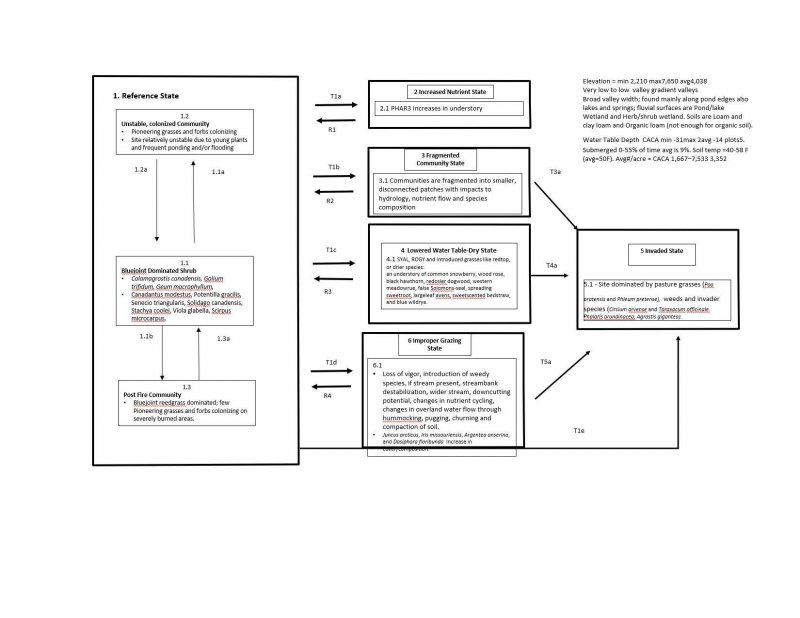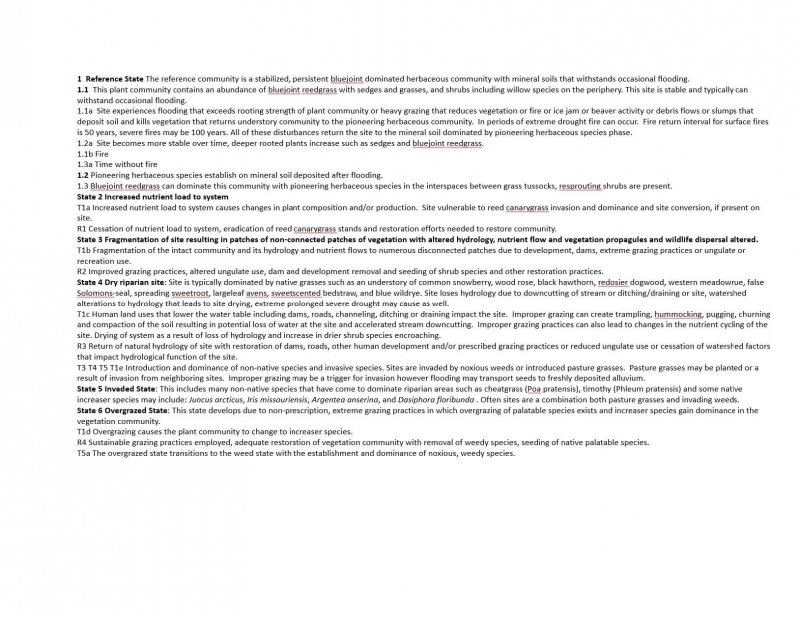
Natural Resources
Conservation Service
Ecological site R044AY502WA
Warm-frigid, Aquic-Xeric, Loamy, Flood Plains (Grass/Sedge) Semi-wet Meadow
Last updated: 9/07/2023
Accessed: 12/19/2025
General information
Provisional. A provisional ecological site description has undergone quality control and quality assurance review. It contains a working state and transition model and enough information to identify the ecological site.
MLRA notes
Major Land Resource Area (MLRA): 044A–Northern Rocky Mountain Valleys
Major Land Resource Area (MLRA): 044A–Northern Rocky Mountain Valleys
Description of MLRAs can be found in: United States Department of Agriculture, Natural Resources Conservation Service. 2006. Land Resource Regions and Major Land Resource Areas of the United States, the Caribbean, and the Pacific Basin. U.S. Department of Agriculture Handbook 296.
LRU notes
Major land resource area (MLRA): 044A-Northern Rocky Mountain Valleys
Modal LRU – 44A01 - Spokane-Rathdrum Outwash Plains
This LRU is composed predominantly of low foothills, outwash plains and valley floors. The soils tend to be loamy to sandy andisols, inceptisols, and mollisols with mixed or distinct ash surfaces. Recent alluvium, till, outwash and residuum from granitic or metamorphic rock are the dominant parent materials. Soil climate is a mesic temperature regime and xeric moisture regime with average annual precipitation around 525 mm (21 inches).
Classification relationships
This ES group fits into the National Vegetation Standard’s Rocky Mountain-Great Basin Riparian Shrubland Group and is most closely related to Washington State’s Natural Heritage Program’s Rocky Mountain Alpine-Montane Wet Meadow but occurs at a lower elevation than is typical. (Compare to previous Washington range site: R044XY602WA, Semi-wet meadow 15+ PZ)
Ecological site concept
This ES is found on loamy soils in drainageways with a water table within 30 inches of the surface and a plant community dominated by grasses and forbs and some shrubs.
Associated sites
| F043AY518WA |
Warm-Frigid, Xeric, Loamy Slopes, mixed ash surface (Douglas-Fir/Warm Dry Shrub) Pseudotsuga menziesii / Physocarpus malvaceus - Symphoricarpos albus This site occurs on hillslopes, mountain slopes, and terraces. They have loamy soil materials and lack a high water table. They do not have a distinct volcanic ash mantle and are very deep. Overstory species include Pseudotsuga menziesii var. glauca,and Pinus ponderosa. The understory is typified by Physocarpus malvaceus, Symphoricarpos albus, Calamagrostis rubescens, and Bromus vulgaris. |
|---|---|
| F043AY521WA |
Warm-Frigid, Moist- Xeric Loamy Foothills/Mountainsides, ashy surface (Grand Fir Warm Dry Shrub) Abies grandis - Pseudotsuga menziesii / Physocarpus malvaceus - Symphoricarpos albus Found on lower Hill slopes, mountain slopes and terraces. Textures are loamy and sites lack a high water table. The soil surface has a dsitinct layer of volcanic ash material. Overstory species include Abies grandis and Pseudotsuga menziesii var. glauca. The understory is typified by Physocarpus malvaceus,Symphoricarpos albus,Calamagrostis rubescens,and Hieracium albiflorum. |
| F043AY512WA |
Warm, Xeric, Loamy Mountainsides, ashy surface (Ponderosa Pine/Dry Grass) Pinus ponderosa / Pseudoroegneria spicata , Pinus ponderosa / Festuca idahoensis This site occurs on very poorly and poorly drained loamy mineral soils in drainageways with a water table within 20 inches of the surface. Site vegetation is dominated by a mix of wetland adapted species including Alnus incana,Salix,Deschampsia cespitosa, and Carex |
Similar sites
| R044AY501WA |
Mesic, Aquic, Organic Depressions and Seeps Found on floodplains and seeps at lower, warmer elevations. Confined to depressions and other areas of water accumulation; water table at 0 to 6 inches with mucky surface texture. Site vegetation is dominated by a mix of wetland adapted species including Spiraea, Alnus viridis , Carex, and Sphagnum |
|---|---|
| R043AY510ID |
Cool-Mesic Aquic Loamy Flood Plains (CAST/CAREX) Found on floodplains and in drainageways. Water table within 30 inches of the surface for some time during spring and summer. They have loamy surface textures. Found in locations where MLRA 44A transitions to MLRA 43A at valley margins and upper reaches. Site vegetation is typified by Carex and Calamagrostis stricta. |
Table 1. Dominant plant species
| Tree |
Not specified |
|---|---|
| Shrub |
Not specified |
| Herbaceous |
(1) Calamagrostis canadensis |
Click on box and path labels to scroll to the respective text.

